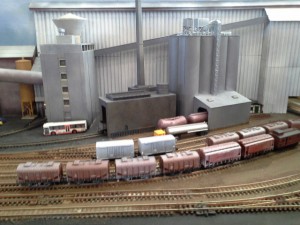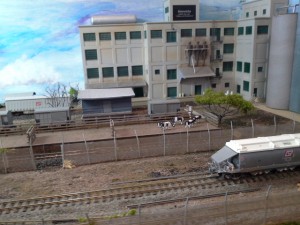Everything on model trains, model railroads, model railways, locomotives, model train layouts, scenery, wiring, DCC and more. Enjoy the world's best hobby... model railroading!
Why Do DCC Bachmann Locomotives Run In Wrong Direction?
Duane asks readers:
“I have Bachmann 2 DCC steam locomotives of the same kind. One of them started moving in the wrong direction. I was using a magnet (which is under the track) that came with the Bachmann train system track to uncouple the rolling stock. While, I was in the process of doing so the train was backing up. Then, it goes in the forward direction on its own and stopped working. Did the decoder die? The warranty is no longer good can this be fixed? ”
How Do I Install A Sound Decoder?
Terry asks readers:
“I have an old Proto 2000 engine which must have owned for at least 15 years, and I want to install a sound decoder. I am a bit frightened where to start and if I’ll do any damage. Do I need to unhook little computer board behind the motor? I presume the old board was partly used to control the MARS signal-safety light. I do have resistors and LED’s. Will this decoder operate with the board in position, or will I have problems? Any advice on installation would be greatly appreciated. Thank you.”
How Many Lights Can Be Run Off A Transformer?
Reynold asks readers for advice:
“My N scale layout has 78 building yard lights not including the signals which I have spread over 4 transformers. If possible I would like to have them set up to all operate off just one power supply specifically for lighting. Is this hard to do? What would I need as a minimum transformer power output? I am hoping someone can shed some light on the problem – sorry about the bad pun!!!”
Using Tall Thin Backdrop Buildings To Save Space and Give The Illusion Your Rail Yard Stretches Full Depth
Rail yards are an important part of most model railroads not just because that look interesting, but also because they provide a lot of operational possibilities. Rail yards shouldn’t become a bottleneck that brings the railroad to a stand still. That can be very frustrating!
At the very least there should be enough track for the trains you’re operating and possibly another couple of tracks for train arrivals and departures. However, finding enough space to operate an efficient rail yard can be a problem, and that’s where background buildings can become a great space-saver.
Instead of using a full-sized 3D building which will potential take up valuable space that could otherwise be used for more track, it is possible to achieve the sane effect with thinner “low relief” 3 sided buildings or “flats” which are just frontages. The backdrop buildings need only be an inch or two deep to still give the illusion the building stretches full depth. That way you’ll have space for more yard track. This video shows some good examples of tall backdrop buildings.
How to make tall these tall backdrop buildings
Derailment On A Switch
Steven has an o-gauge, 3 rail layout and asks readers:
“I have a switch that I put it in a loop, so the engine can come back in a different direction. Problem is; once the switch is in main line straight and the engine goes through it, no problem, but when engine is coming around the loop, the engine approach it for a curve switch and the switch freezes on the straight line and it does not turn to a curve position for the engine to go in opposite direction, which causes a derailment. How can I fix this problem. I have limited space for this layout. Please help!!!!!!!!!! Thanks.”
Will 8 Amps Damage My Engines?
Club member Frank has a question for readers:
“I have been dabbling in the hobby for some time now but only in a small space. I thought I would expand my N scale track in another room and go DCC with eventually 8 to 10 engines – that’s my dream. A fellow at the train show said an 8 amp unit might damage my engines and I would be safer sticking to 5 amps. I thought that sounded kinda weird?? Is he right?”
Plans for 3 New Silo Facilities
Don’t panic! If you are not skilled with an airbrush, you don’t need to be… because these 3 new structures are already detailed and weathered to a very high standard. So… NO airbrushing or painting is needed!
- Silo facility #1 (plan B530) is the Silo Storage Company complex
- Silo facility #2 (plan B531) is the Advance Rail Forwarders complex
- Silo facility #3 (plan B532) is the Bulk Road & Rail Silos complex
Plans available from http://www.modelbuildings.org/industrial-silos-models-to-make.html
What to use for Benchwork Materials
Jerome asks readers:
“This will be my first layout when I finally pluck up the courage to get started. I have been doing heaps of reading and research on trains and wiring but taking the first step with construction is harder than I thought. I guess it’s because I’m a bit of a control freak, not very skilled with carpentry, and don’t want to stuff anything up. I have a 12ft x 8ft space and have decided on HO. I thought of using radiata pine for the frame and MDF for the base. Is this ok? What thickness is best? I just need a push to get me started.”
Whats The Best Model Railroad Aisle Width
This quick tip will be particularly helpful for beginners who don’t yet have a layout.
How To Build Rail Bridges
Ryan has a question for readers:
“I am a very new beginner. My train room isn’t built yet but is underway. My HO layout is going to be an L shape and I want to know how to add a couple bridges and waterfall features. Will I have raise my layout up from the beginning and make a gap along the track to implement a bridge? What’s the best material and any advice is appreciated. Thanks.”
Switches and Frogs
Alan asks readers:
“I am having frustrating times with my trains derailing – both locomotives and cars. It is the frogs in the switch that is causing the derailments. I have checked and double checked the switch tension to no avail. Can someone guide me to a solution please?”
NEW! 6 Rail Yard Buildings – Just Released
Just Released are plans for these 6 new railroad yard buildings.The video (which is less than a minute long) shows all 6 buildings. It even shows a close up of one of the buildings revealing the intricate detailing and weathering techniques. These plans can be constructed using whichever materials you prefer using – card, corflute, balsa, foam sheet… you decide. More photos and details are on the web page http://www.modelbuildings.org/railroad-yard-designs.html
They can be purchased individually on as a package deal saving 68%!
Model Train Beginner Seeks Advice
 Marcel is just starting in the hobby and seeks advice from readers:
Marcel is just starting in the hobby and seeks advice from readers:
“Although slowly moving along, below is a picture of my “To be” Train table. It is a Ping Pong table with 3” high foam board. Also, I have a mountain kit. What I would like to ask is what should my next step be? I have a Bachmann Acela Speed Train that if possible will run the perimeter of the lay-out. Since the mountain has only one tunnel opening, I guess the Acela will utilize it. Do you know of any good ‘somewhat beginner’ resources? Any advice you can provide?”
Power For Diesel Area 51 Locomotive
 Joe sent in this idea to share –
Joe sent in this idea to share –
I just wanted to tell you about the fix I came up with for my Lionel wireless locomotives. I bought two locomotives from a hobby shop last Christmas. One is the diesel Area 51 and the Scout locomotive. These locomotives run on the track with wide open power for the transformer and controlled by a battery operated hand held pendant. I supply power to them from a Z transformer. When I had a derailment or passing through a track switch, the track would short out, causing both locomotive components to burn up. However Lionel did honor their warranty, I wanted a better fix. I laid out a dedicated track without switches.
My theory is that with AC current from the transformer to the track is 18 Volts. The Z transformer has higher Amperage output than smaller transformers. I relate electricity like plumbing. Voltage as the water pressure and Amperage as the water supply. There are two legs from the transformer, a hot and a common. In ideal conditions, the AC current is produced evenly on both legs. If of the legs allows more electronic flow than the other, (short) the voltage drops like water pressure would. At this time the transformer tries to keep the balance by using providing more amperage to produce more voltage. This is called an IN RUSH. When the higher voltage is supplied to the components it is turned back to Amperage, through resistance and heats up the components burning them up.
I couldn’t get any information from Lionel as to what the accepted threshold of amperage is for the their locomotives.
As a fix, I went to the auto parts store and purchased a Buss fuse holder and a box of 5 AMP fuses. I wired up the fuse holder in series to hot terminal of the transformer to the track. When there is a derailment or a short, the fuses blow instantly without damaging the locomotives.
With the 027 tracks, Switches tend to have small shorts as a lighted car on some locomotives pass through. Lionel calls them snaps. These snaps will burn out the locomotives if not protected in your train stops in the switch over a very short time..
I know it’s confusing to some, but the fix works. Some new transformers produced by Lionel have this protection as a circuit breaker starting around $150.00.
Is N Scale Too Small for a 15 ft by 6 ft Layout?
Andy asks readers:
“I am a 74 year old neophyte planning to build either an HO or N scale layout. My platform is 15 feet by 6 feet. It was suggested to me that working in N scale was too difficult for someone my age because of the difficulty dealing with small details. Any suggestions would be appreciated.”



















